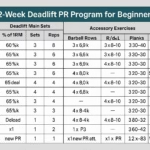Whether you’re preparing for your first powerlifting competition or looking to test your absolute strength limits, a well-structured peaking program is essential for maximizing your performance. This comprehensive 5-week powerlifting peaking program is designed to systematically reduce volume while increasing intensity, allowing you to express your true strength potential when it matters most.
Click Here to get full powerlifting peaking program completely for free.
What Is Powerlifting Peaking?
Powerlifting peaking is the strategic process of reducing training volume while maintaining or increasing intensity to optimize neuromuscular readiness for maximum strength expression. Unlike traditional strength building phases that focus on accumulating volume, peaking programs prioritize nervous system recovery and skill refinement at competition-level intensities.
The goal isn’t to build new strength during these five weeks—it’s to reveal the strength you’ve already developed through months of dedicated training.
Program Overview
This 5-week peaking program follows a linear progression model, systematically increasing intensity while decreasing volume across all four main powerlifting movements:
Training Schedule: 4 days per week Main Lifts: Squat, Bench Press, Deadlift, Overhead Press Duration: 5 weeks Target: Competition preparation or strength testing
Weekly Structure
- Day 1: Squat Focus
- Day 2: Bench Press Focus
- Day 3: Deadlift Focus
- Day 4: Overhead Press Focus
Click Here to get full powerlifting peaking program completely for free.
Intensity and Volume Progression
The program follows a carefully calibrated progression that balances high-intensity work with adequate recovery:
Week-by-Week Breakdown
Week 1: Foundation Building
- Volume: 4 sets × 5 reps
- Intensity: 70-75% 1RM
- RPE: 6.5-7
- Focus: Technical refinement at moderate intensity
Week 2: Intensity Introduction
- Volume: 4 sets × 4 reps
- Intensity: 75-80% 1RM
- RPE: 7-7.5
- Focus: Adapting to higher loads
Week 3: Heavy Singles Preparation
- Volume: 3 sets × 3 reps
- Intensity: 80-85% 1RM
- RPE: 7.5-8
- Focus: Neurological adaptation to heavy weights
Week 4: Opener Confidence
- Volume: 3 sets × 2 reps
- Intensity: 85-90% 1RM
- RPE: 8-8.5
- Focus: Competition rhythm and timing
Week 5: Peak Expression
- Volume: 2 sets × 1 rep
- Intensity: 90-95% 1RM
- RPE: 8.5-9
- Focus: Maximum strength expression
Detailed Exercise Selection
Squat Day Programming
Main Movement: Back Squat (competition style) Accessories:
- Front Squat (3×8) – Develops quadriceps strength and upper back stability
- Leg Press (3×8) – Volume work without spinal loading
- Leg Curl (3×8) – Hamstring balance and injury prevention
- Ab Rollout (3×8) – Core stability for heavy squats
Bench Press Day Programming
Main Movement: Competition Bench Press Accessories:
- Close Grip Bench Press (3×8) – Tricep strength and lockout power
- Incline Dumbbell Press (3×8) – Upper chest development
- Chest Fly (3×8) – Pectoral isolation and shoulder health
- Tricep Pushdown (3×8) – Lockout strength
Click Here to get full powerlifting peaking program completely for free.
Deadlift Day Programming
Main Movement: Competition Deadlift Accessories:
- Deficit Deadlift (3×8) – Off-the-floor strength and range of motion
- Barbell Row (3×8) – Posterior chain balance
- Lat Pulldown (3×8) – Upper back strength and stability
- Back Extension (3×8) – Erector spinae endurance
Overhead Press Day Programming
Main Movement: Strict Overhead Press
Accessories:
- Overhead Press Volume Work (3×8) – Additional pressing volume
- Dumbbell Lateral Raise (3×8) – Deltoid isolation
- Face Pull (3×8) – Rear deltoid and upper back health
Implementation Guidelines
Getting Started
- Establish Accurate 1RMs: Use recent max attempts or reliable calculators based on recent training
- Input Your Numbers: The program automatically calculates working weights based on your 1RM inputs
- Plan Your Peak: Schedule your competition or max attempt testing for the week following completion
Training Tips
- Warm-up Thoroughly: Longer warm-ups become increasingly important as intensity rises
- Focus on Technique: Use lighter weights to perfect your competition commands and timing
- Monitor Recovery: Sleep, nutrition, and stress management become critical during peaking
- Practice Competition Routine: Simulate competition timing and procedures
Rest and Recovery
- Between Sets: 3-5 minutes for main lifts, 2-3 minutes for accessories
- Between Sessions: Minimum 24 hours, preferably 48 hours between similar movement patterns
- Sleep: Prioritize 7-9 hours of quality sleep nightly
- Nutrition: Maintain consistent eating patterns; avoid drastic dietary changes
Expected Outcomes
By the end of this 5-week program, you should experience:
- Increased Confidence: Handling 90%+ loads with improved technique
- Enhanced Neurological Efficiency: Better force production and motor unit recruitment
- Reduced Fatigue: Lower training volume allows for superior recovery
- Competition Readiness: Familiarity with heavy singles and competition timing
- Strength Expression: The ability to demonstrate your true maximum strength
Who Should Use This Program
Ideal Candidates
- Intermediate to advanced lifters with 1+ years of consistent training
- Athletes preparing for powerlifting competitions
- Lifters wanting to test their maximum strength safely
- Those coming off a strength-building phase
Prerequisites
- Established 1RM baselines for all lifts
- Solid technique across all competition movements
- No current injuries or movement restrictions
- Previous experience with RPE-based training
FAQs
Q: How do I determine my starting 1RM if I haven’t tested recently?
A: Use a recent heavy triple (3RM) and multiply by 1.05-1.08, or a heavy single at RPE 8-9 and add 5-10% depending on the lift. Conservative estimates work better than aggressive ones for peaking programs.
Q: What if I miss a prescribed rep or weight during the program?
A: If you miss reps consistently, reduce all percentages by 2-3%. Missing occasionally is normal, but frequent misses indicate your starting 1RM was too optimistic.
Q: Can I add extra accessory work or cardio during this program?
A: Minimize additional work during peaking. The program is designed with optimal volume. Extra work can interfere with recovery and peak performance. Light walking or mobility work is fine.
Q: Should I deload before starting this program?
A: Yes, ideally take 3-5 days of complete rest or very light training before beginning. You should feel fresh and recovered when starting Week 1.
Q: What if I don’t have access to some of the accessory exercises?
A: Substitute with similar movement patterns. For example: leg press can be replaced with goblet squats, chest flyes with push-ups, etc. Maintain the same rep ranges and intensity.
Q: How should I warm up for the heavy singles in Week 5?
A: Take more warm-up sets than usual. A typical progression might be: empty bar×10, 50%×5, 70%×3, 80%×1, 85%×1, then your working weight. Listen to your body and add sets if needed.
Q: Can I compete immediately after finishing this program?
A: The program is designed to peak you at the end of Week 5. Schedule your competition for the weekend after completing the program, or take 2-3 days of complete rest before competing.
Q: What if I’m not feeling strong during the early weeks?
A: This is normal! The first 2-3 weeks often feel harder than expected as your body adapts to the new stimulus. Trust the process—strength expression typically comes in Weeks 4-5.
Q: Should I attempt new personal records during this program?
A: No, save PRs for the end. The program percentages are designed to build toward peak performance. Attempting early PRs can disrupt the planned progression and compromise your final results.
Q: How do I transition back to regular training after peaking?
A: Take 5-7 days of complete rest after your peak attempt, then return to moderate volume and intensity. Consider starting a new training block focused on addressing weaknesses identified during the peak.



